2014 NISSAN VERSA NOTE stop start
[x] Cancel search: stop startPage 289 of 372
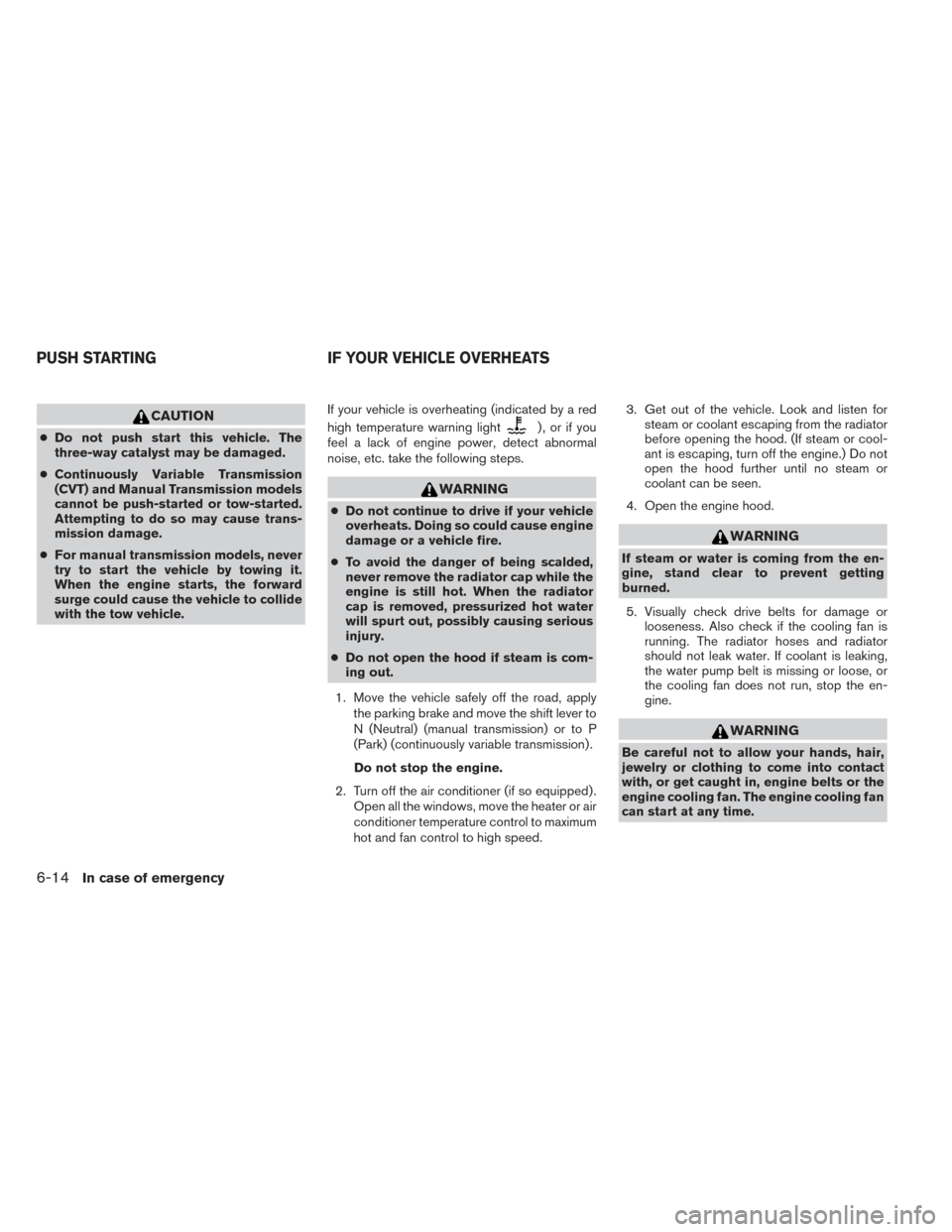
CAUTION
●Do not push start this vehicle. The
three-way catalyst may be damaged.
● Continuously Variable Transmission
(CVT) and Manual Transmission models
cannot be push-started or tow-started.
Attempting to do so may cause trans-
mission damage.
● For manual transmission models, never
try to start the vehicle by towing it.
When the engine starts, the forward
surge could cause the vehicle to collide
with the tow vehicle. If your vehicle is overheating (indicated by a red
high temperature warning light) , or if you
feel a lack of engine power, detect abnormal
noise, etc. take the following steps.
WARNING
● Do not continue to drive if your vehicle
overheats. Doing so could cause engine
damage or a vehicle fire.
● To avoid the danger of being scalded,
never remove the radiator cap while the
engine is still hot. When the radiator
cap is removed, pressurized hot water
will spurt out, possibly causing serious
injury.
● Do not open the hood if steam is com-
ing out.
1. Move the vehicle safely off the road, apply the parking brake and move the shift lever to
N (Neutral) (manual transmission) or to P
(Park) (continuously variable transmission) .
Do not stop the engine.
2. Turn off the air conditioner (if so equipped) . Open all the windows, move the heater or air
conditioner temperature control to maximum
hot and fan control to high speed. 3. Get out of the vehicle. Look and listen for
steam or coolant escaping from the radiator
before opening the hood. (If steam or cool-
ant is escaping, turn off the engine.) Do not
open the hood further until no steam or
coolant can be seen.
4. Open the engine hood.
WARNING
If steam or water is coming from the en-
gine, stand clear to prevent getting
burned.
5. Visually check drive belts for damage or looseness. Also check if the cooling fan is
running. The radiator hoses and radiator
should not leak water. If coolant is leaking,
the water pump belt is missing or loose, or
the cooling fan does not run, stop the en-
gine.
WARNING
Be careful not to allow your hands, hair,
jewelry or clothing to come into contact
with, or get caught in, engine belts or the
engine cooling fan. The engine cooling fan
can start at any time.
PUSH STARTING IF YOUR VEHICLE OVERHEATS
6-14In case of emergency
Page 312 of 372
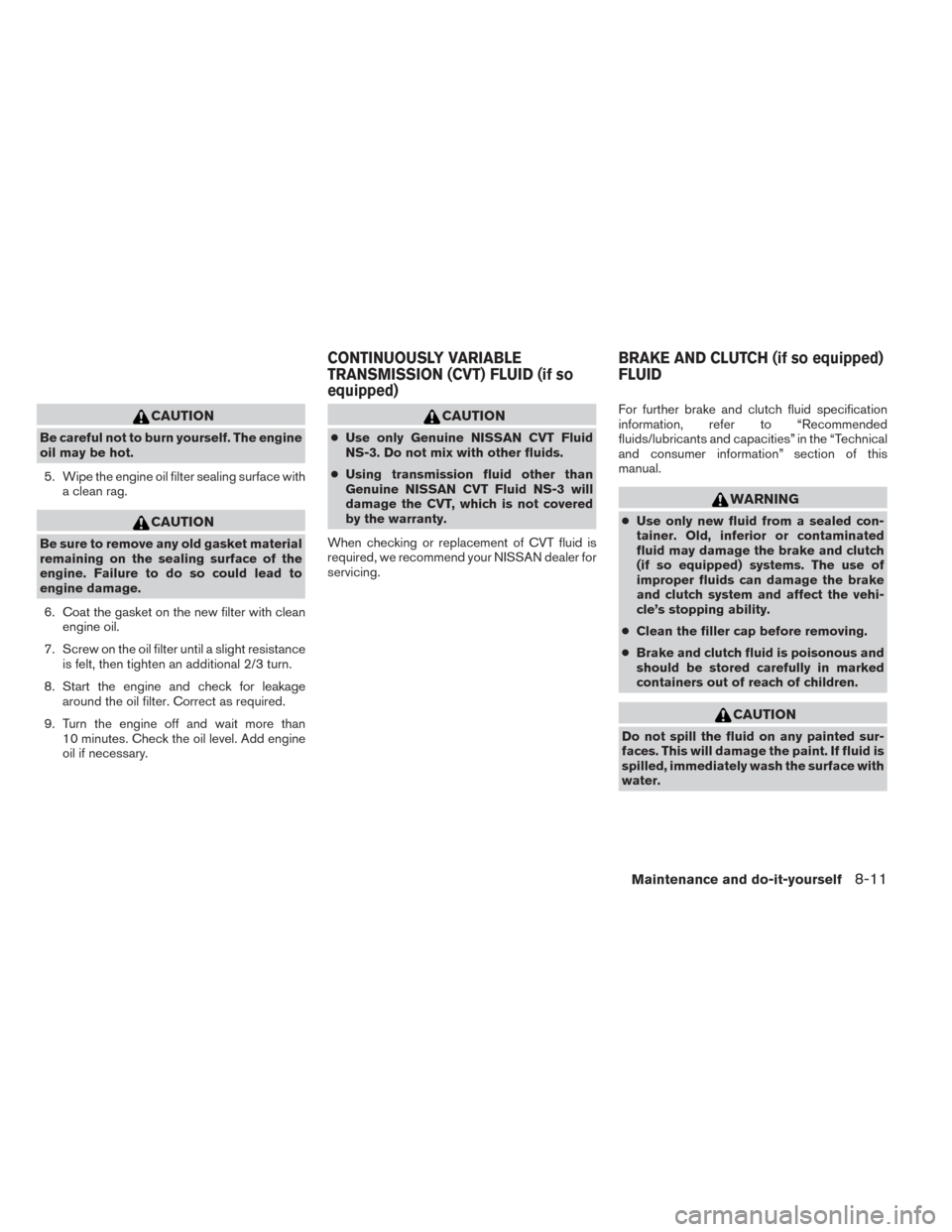
CAUTION
Be careful not to burn yourself. The engine
oil may be hot.5. Wipe the engine oil filter sealing surface with a clean rag.
CAUTION
Be sure to remove any old gasket material
remaining on the sealing surface of the
engine. Failure to do so could lead to
engine damage.
6. Coat the gasket on the new filter with clean engine oil.
7. Screw on the oil filter until a slight resistance is felt, then tighten an additional 2/3 turn.
8. Start the engine and check for leakage around the oil filter. Correct as required.
9. Turn the engine off and wait more than 10 minutes. Check the oil level. Add engine
oil if necessary.
CAUTION
●Use only Genuine NISSAN CVT Fluid
NS-3. Do not mix with other fluids.
● Using transmission fluid other than
Genuine NISSAN CVT Fluid NS-3 will
damage the CVT, which is not covered
by the warranty.
When checking or replacement of CVT fluid is
required, we recommend your NISSAN dealer for
servicing. For further brake and clutch fluid specification
information, refer to “Recommended
fluids/lubricants and capacities” in the “Technical
and consumer information” section of this
manual.
WARNING
●
Use only new fluid from a sealed con-
tainer. Old, inferior or contaminated
fluid may damage the brake and clutch
(if so equipped) systems. The use of
improper fluids can damage the brake
and clutch system and affect the vehi-
cle’s stopping ability.
● Clean the filler cap before removing.
● Brake and clutch fluid is poisonous and
should be stored carefully in marked
containers out of reach of children.
CAUTION
Do not spill the fluid on any painted sur-
faces. This will damage the paint. If fluid is
spilled, immediately wash the surface with
water.
CONTINUOUSLY VARIABLE
TRANSMISSION (CVT) FLUID (if so
equipped) BRAKE AND CLUTCH (if so equipped)
FLUID
Maintenance and do-it-yourself8-11
Page 358 of 372
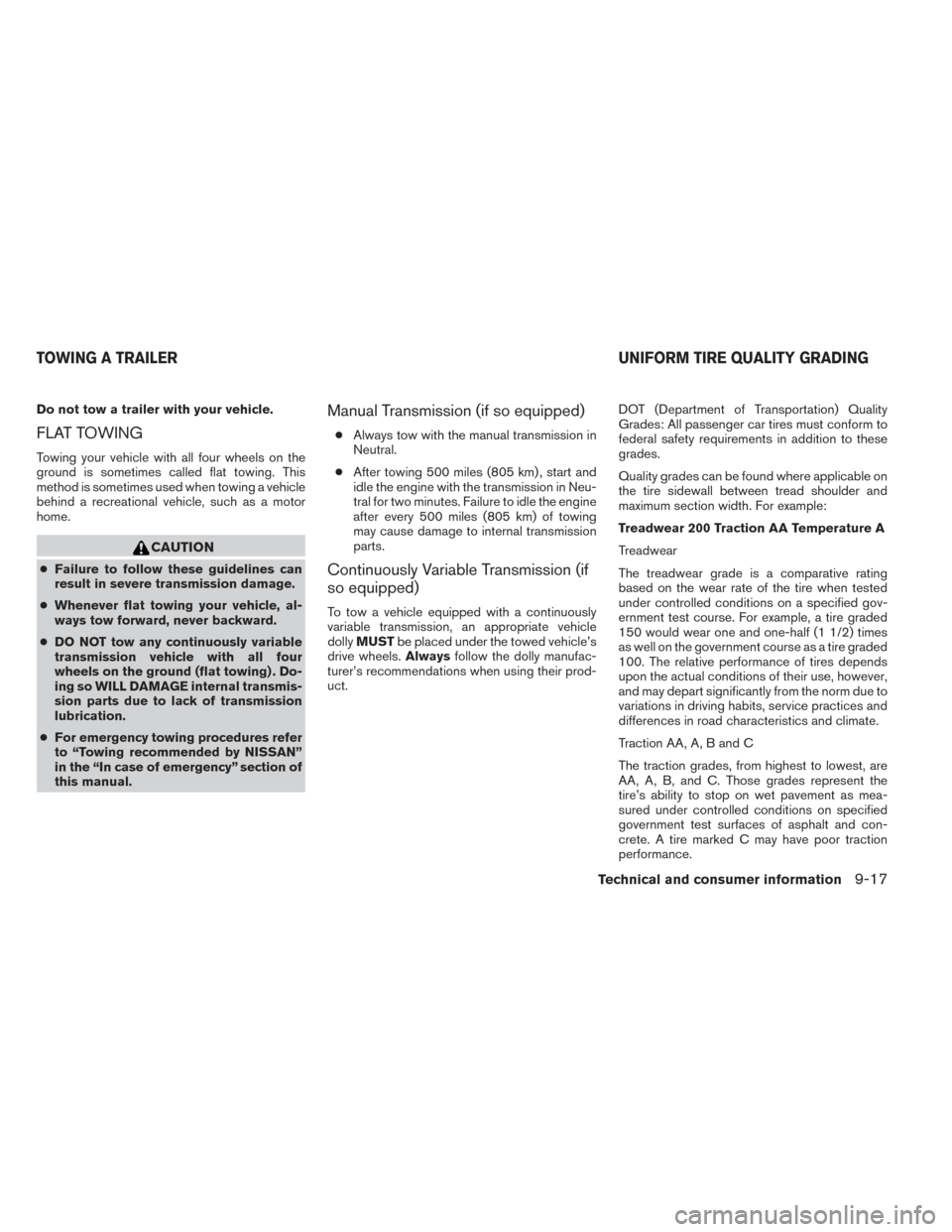
Do not tow a trailer with your vehicle.
FLAT TOWING
Towing your vehicle with all four wheels on the
ground is sometimes called flat towing. This
method is sometimes used when towing a vehicle
behind a recreational vehicle, such as a motor
home.
CAUTION
●Failure to follow these guidelines can
result in severe transmission damage.
● Whenever flat towing your vehicle, al-
ways tow forward, never backward.
● DO NOT tow any continuously variable
transmission vehicle with all four
wheels on the ground (flat towing) . Do-
ing so WILL DAMAGE internal transmis-
sion parts due to lack of transmission
lubrication.
● For emergency towing procedures refer
to “Towing recommended by NISSAN”
in the “In case of emergency” section of
this manual.
Manual Transmission (if so equipped)
● Always tow with the manual transmission in
Neutral.
● After towing 500 miles (805 km) , start and
idle the engine with the transmission in Neu-
tral for two minutes. Failure to idle the engine
after every 500 miles (805 km) of towing
may cause damage to internal transmission
parts.
Continuously Variable Transmission (if
so equipped)
To tow a vehicle equipped with a continuously
variable transmission, an appropriate vehicle
dolly MUST be placed under the towed vehicle’s
drive wheels. Alwaysfollow the dolly manufac-
turer’s recommendations when using their prod-
uct. DOT (Department of Transportation) Quality
Grades: All passenger car tires must conform to
federal safety requirements in addition to these
grades.
Quality grades can be found where applicable on
the tire sidewall between tread shoulder and
maximum section width. For example:
Treadwear 200 Traction AA Temperature A
Treadwear
The treadwear grade is a comparative rating
based on the wear rate of the tire when tested
under controlled conditions on a specified gov-
ernment test course. For example, a tire graded
150 would wear one and one-half (1 1/2) times
as well on the government course as a tire graded
100. The relative performance of tires depends
upon the actual conditions of their use, however,
and may depart significantly from the norm due to
variations in driving habits, service practices and
differences in road characteristics and climate.
Traction AA, A, B and C
The traction grades, from highest to lowest, are
AA, A, B, and C. Those grades represent the
tire’s ability to stop on wet pavement as mea-
sured under controlled conditions on specified
government test surfaces of asphalt and con-
crete. A tire marked C may have poor traction
performance.
TOWING A TRAILER
UNIFORM TIRE QUALITY GRADING
Technical and consumer information9-17
Page 364 of 372
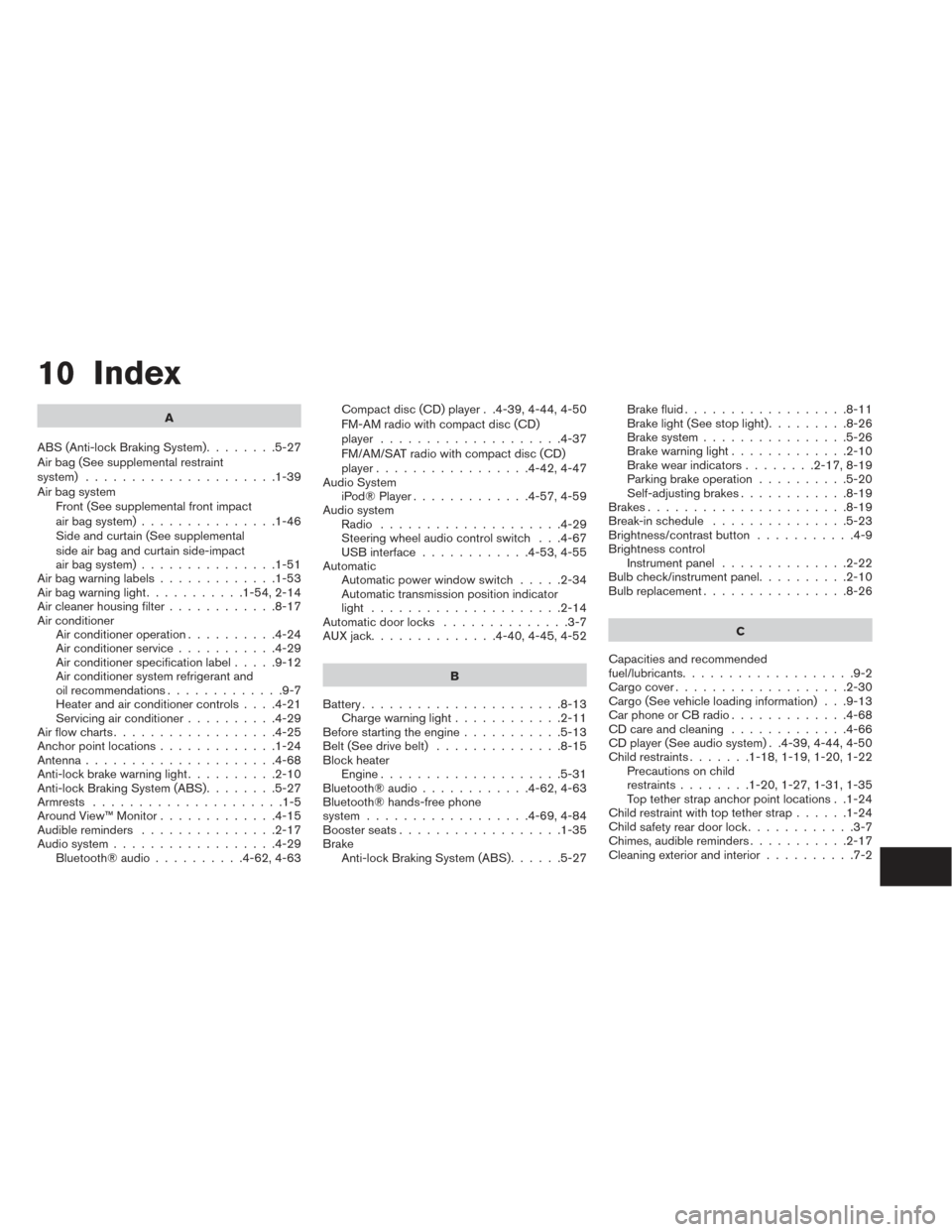
10 Index
A
ABS (Anti-lock Braking System) ........5-27
Air bag (See supplemental restraint
system) .....................1-39
Air bag system Front (See supplemental front impact
air bag system) ...............1-46
Side and curtain (See supplemental
side air bag and curtain side-impact
air bag system) ...............1-51
Airbagwarninglabels.............1-53
Airbagwarninglight...........1-54,2-14
Air cleaner housing filter ............8-17
Air conditioner Air conditioner operation ..........4-24
Air conditioner service ...........4-29
Air conditioner specification label .....9-12
Air conditioner system refrigerant and
oil recommendations .............9-7
Heater and air conditioner controls ....4-21
Servicing air conditioner ..........4-29
Airflowcharts..................4-25
Anchor point locations .............1-24
Antenna.....................4-68
Anti-lock brake warning light ..........2-10
Anti-lock Braking System (ABS) ........5-27
Armrests .....................1-5
AroundView™Monitor.............4-15
Audible reminders ...............2-17
Audio system ..................4-29
Bluetooth®audio..........4-62,4-63 Compact disc (CD) player . .4-39, 4-44, 4-50
FM-AM radio with compact disc (CD)
player ....................4-37
FM/AM/SAT radio with compact disc (CD)
player.................4-42,4-47
Audio System iPod®Player.............4-57,4-59
Audio system Radio ....................4-29
Steering wheel audio control switch . . .4-67
USB interface ............4-53,4-55
Automatic Automatic power window switch .....2-34
Automatic transmission position indicator
light .....................2-14
Automatic door locks ..............3-7
AUXjack..............4-40,4-45,4-52
B
Battery ......................8-13
Charge warning light ............2-11
Before starting the engine ...........5-13
Belt (See drive belt) ..............8-15
Block heater Engine ....................5-31
Bluetooth®audio............4-62,4-63
Bluetooth® hands-free phone
system ..................4-69,4-84
Boosterseats..................1-35
Brake Anti-lock Braking System (ABS) ......5-27Brakefluid..................8-11
Brakelight(Seestoplight).........8-26
Brake system
................5-26
Brake warning light .............2-10
Brake wear indicators ........2-17,8-19
Parking brake operation ..........5-20
Self-adjusting brakes ............8-19
Brakes ......................8-19
Break-inschedule ...............5-23
Brightness/contrast button ...........4-9
Brightness control Instrument panel ..............2-22
Bulb check/instrument panel ..........2-10
Bulbreplacement................8-26
C
Capacities and recommended
fuel/lubricants ...................9-2
Cargocover...................2-30
Cargo (See vehicle loading information) . . .9-13
Car phone or CB radio .............4-68
CD care and cleaning .............4-66
CD player (See audio system) . .4-39, 4-44, 4-50
Child restraints .......1-18,1-19,1-20,1-22
Precautions on child
restraints ........1-20,1-27,1-31,1-35
Top tether strap anchor point locations . .1-24
Child restraint with top tether strap ......1-24
Child
safety rear door lock ............3-7
Chimes,audiblereminders...........2-17
Cleaning exterior and interior ..........7-2
Page 366 of 372
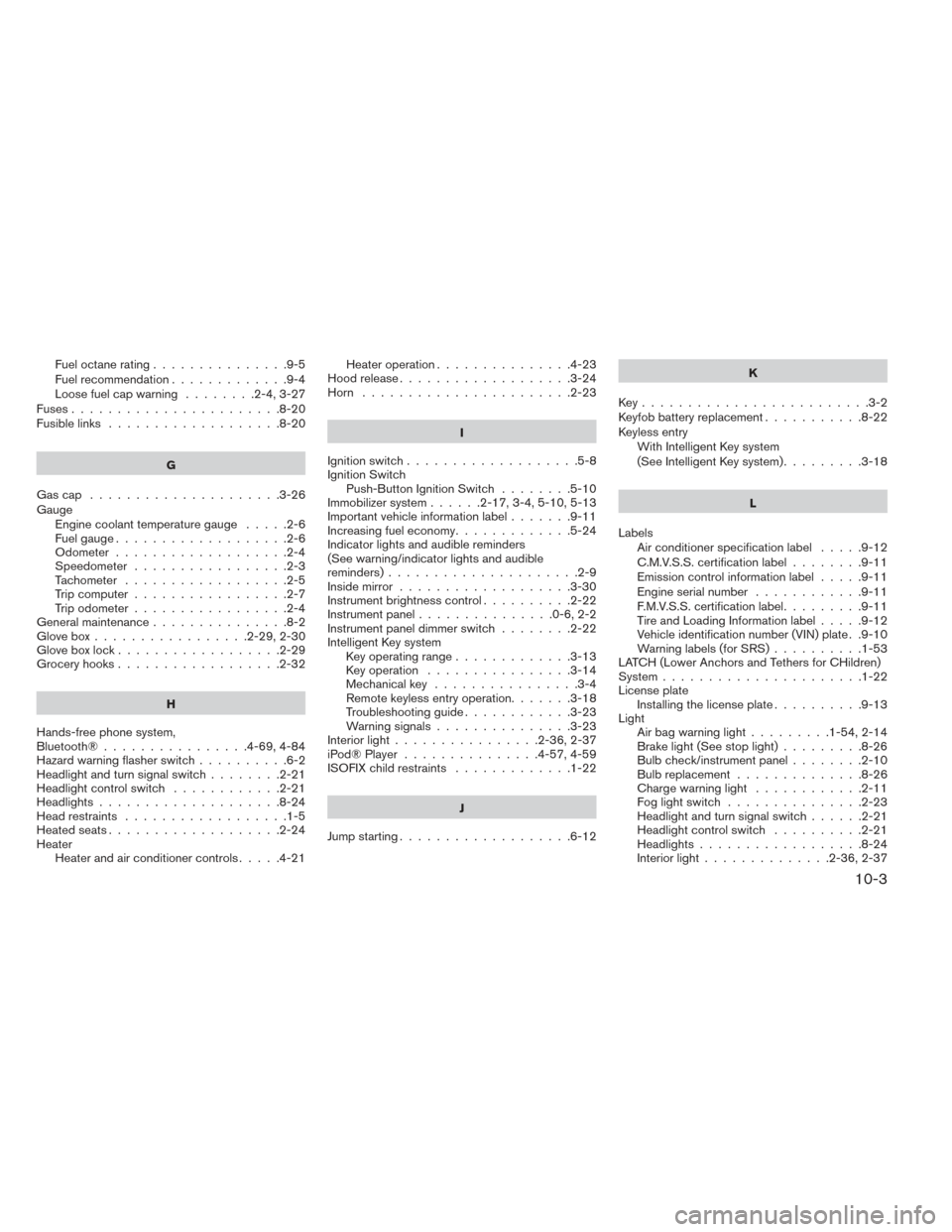
Fueloctanerating...............9-5
Fuel recommendation.............9-4
Loosefuelcapwarning ........2-4,3-27
Fuses.......................8-20
Fusiblelinks ...................8-20
G
Gascap .....................3-26
Gauge Engine coolant temperature gauge .....2-6
Fuel gauge ...................2-6
Odometer ...................2-4
Speedometer .................2-3
Tachometer ..................2-5
Trip computer .................2-7
Trip odometer .................2-4
Generalmaintenance...............8-2
Glovebox.................2-29,2-30
Gloveboxlock..................2-29
Grocery hooks ..................2-32
H
Hands-free phone system,
Bluetooth®................4-69,4-84
Hazard warning flasher switch ..........6-2
Headlightandturnsignalswitch........2-21
Headlightcontrolswitch ............2-21
Headlights....................8-24
Head restraints ..................1-5
Heated seats ...................2-24
Heater Heater and air conditioner controls .....4-21Heater operation
...............4-23
Hood release ...................3-24
Horn .......................2-23
I
Ignition switch ...................5-8
Ignition Switch Push-Button Ignition Switch ........5-10
Immobilizer system ......2-17,3-4,5-10,5-13
Important vehicle information label .......9-11
Increasing fuel economy .............5-24
Indicator lights and audible reminders
(See warning/indicator lights and audible
reminders).....................2-9
Inside mirror ...................3-30
Instrument brightness control ..........2-22
Instrument panel ...............0-6,2-2
Instrument panel dimmer switch ........2-22
Intelligent Key system Key operating range .............3-13
Key operation ................3-14
Mechanicalkey ................3-4
Remote keyless entry operation .......3-18
Troubleshooting guide ............3-23
Warning signals ...............3-23
Interiorlight................2-36,2-37
iPod® Player ...............4-57,4-59
ISOFIX child restraints .............1-22
J
Jump starting ...................6-12 K
Key.........................3-2
Keyfob battery replacement ...........8-22
Keyless entry With Intelligent Key system
(See Intelligent Key system) .........3-18
L
Labels Air conditioner specification label .....9-12
C.M.V.S.S. certification label ........9-11
Emission control information label .....9-11
Engine serial number ............9-11
F.M.V.S.S. certification label .........9-11
Tire and Loading Information label .....9-12
Vehicle identification number (VIN) plate . .9-10
Warning labels (for SRS) ..........
1-53
LATCH (Lower Anchors and Tethers for CHildren)
System ......................1-22
License plate Installing the license plate ..........9-13
Light Airbagwarninglight.........1-54, 2-14
Brake light (See stop light) .........8-26
Bulb check/instrument panel ........2-10
Bulbreplacement..............8-26
Chargewarninglight ............2-11
Fog light switch ...............2-23
Headlightandturnsignalswitch......2-21
Headlight control switch ..........2-21
Headlights..................8-24
Interiorlight..............2-36,2-37
10-3
Page 368 of 372

Steering wheel audio control switch....4-67
Readiness for inspection maintenance
(I/M) test .....................9-20
Rearcenterseatbelt ..............1-15
Rear power windows ..............2-34
Rearseat......................1-4
RearViewMonitor.................4-9
Rear window defroster switch .........2-20
Rear window wiper and washer switches . . .2-20
Recorders Eventdata..................9-20
Refrigerant recommendation ...........9-7
Registering your vehicle in another country . .9-10
Reporting safety defects (US only) .......9-19
S
Safety Child safety rear door lock ..........3-7
Childseatbelts.....1-20,1-27,1-31,1-35
Reporting safety defects (US only) .....9-19
Seat adjustment Front manual seat adjustment ........1-2
Rear seat adjustment .............1-4
Seatback pockets ................2-27
Seat belt Childsafety..................1-18
Infantsandsmallchildren..........1-19
Injured Person ................1-12
Largerchildren................1-19
Precautionsonseatbeltusage........1-9
Pregnant women ...............1-12
Rear center seat belt ............1-15
Seat belt extenders .............1-17
Seat belt maintenance ............1-18 Seatbelts ...................1-9
Shoulder belt height adjustment
......1-17
Three-point type with retractor .......1-12
Seat belt warning light ..............2-14
Seats Adjustment ...................1-2
Frontseats...................1-2
Heatedseats.................2-24
Manual front seat adjustment .........1-2
Rearseat....................1-4
Security indicator light ..............2-16
Security system (NISSAN vehicle immobilizer
system) , engine start .....2-17,3-4,5-10,5-13
Self-adjusting brakes ..............8-19
Service manual order form ...........9-21
Servicing air conditioner .............4-29
Setting button ...................4-5
Shifting Continuously Variable Transmission
(CVT) .....................5-16
Manual transmission .............5-19
Shoulder belt height adjustment ........1-17
Side air bag system
(See supplemental side air bag and
curtain side-impact air bag system) ......1-51
Sparkplugreplacement.............8-16
Speedometer ...................2-3
SRSwarninglabel................1-53
Starting Before starting the engine ..........5-13
Jump starting .................6-12
Precautions when starting and driving ....5-2
Push starting .................6-14
Starting the engine .............5-14 Steering
Power steering system ...........5-26
Tilting steering wheel ............3-29
Steering wheel audio control switch ......4-67
Stoplight.....................8-26
Storage......................2-27
Storage tray ...................2-28
Sun visors ....................3-29
Supplemental air bag warning labels ......1-53
Supplemental air bag warning light . . .1-54, 2-14
Supplemental front impact air bag system . . .1-46
Supplemental restraint system Information and warning labels .......1-53
Precautions
on supplemental restraint
system ....................1-39
Supplemental restraint system
(Supplemental air bag system) .........1-39
Supplemental side and curtain side-impact
air bag system ..................1-51
Switch Automatic power window switch ......2-34
Fog light switch ...............2-23
Hazard warning flasher switch ........6-2
Headlightandturnsignalswitch......2-21
Headlight control switch ..........2-21
Ignition switch .................5-8
Power door lock switch ............3-6
Rearwindowdefrosterswitch .......2-20
Rear window wiper and washer
switches...................2-20
Turnsignalswitch..............2-23
Vehicle dynamic control (VDC) off
switch .....................2-25
Windshield wiper and washer switch . . .2-19
10-5